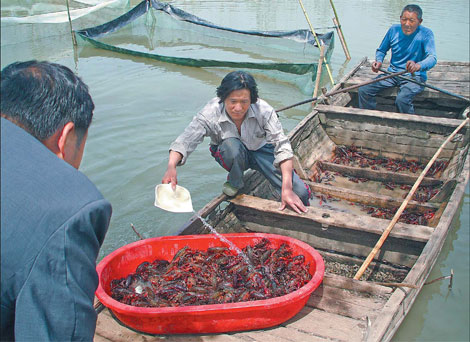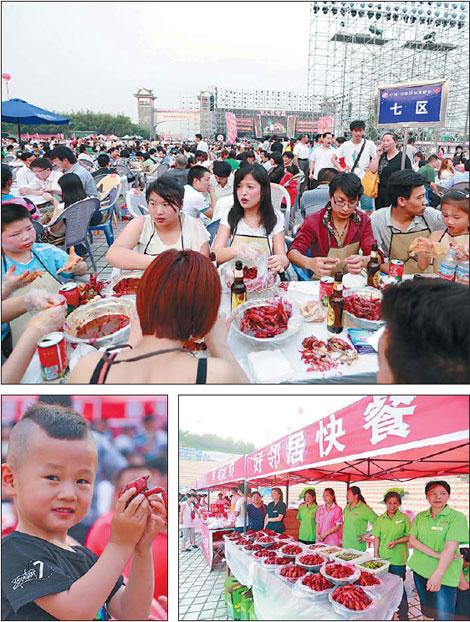Shell of a meal
Updated: 2012-06-24 07:41
By Tang Zhihao (China Daily)
|
|||||||||
|
Farmers at a local crayfish breeding yard prepare their harvest for the market in Xuyi county, Jiangsu province of East China. Provided to China Daily |
Residents of a Jiangsu county dine on crayfish to celebrate Duanwu Festival. Tang Zhihao reports in Shanghai.
While the tradition of munching on zongzi (pyramidal rice dumplings) during Duanwu (Dragon Boat) Festival has persisted wherever Chinese live around the globe, it's only in Jiangsu province's Xuyi county that people also have the custom of eating crayfish during the celebration.
Because he adores crayfish, white-collar Shanghai worker Zhao Shuqi is a frequent visitor to Shanghai's Shouning Road, which is celebrated for seafood and aquaculture. But he says he isn't sure of the crayfish offerings there compared with Xuyi's.
"Many Shanghai restaurants claim their crayfish come from Xuyi, but I can't tell which are telling the truth, since I've never been to the county," he says.
"So, I plan to visit Xuyi this year to discover the real taste of Xuyi crayfish."
Doing exactly that is what draws most foodies to the county. People like Zhao have continued driving demand for crayfish from the county.
The Jiangsu Xuyi Crayfish Association says it expects more than 2 million visitors to the county of 670,000 residents from March to September this year, compared with about 300,000 in the early 2000s. The period is locally known as "crayfish season".
Most visitors are from the Yangtze River Delta region. A consumer will spend about 1,500 yuan ($235) on average for a two- to three-day trip.
Li Jichun, an accountant from Anhui province, recalls visiting Xuyi for the first time with eight friends in 2007. They ate about 10 kilograms of crayfish on the first night, Li says.
"You see crayfish restaurants everywhere on the street. The air smells like crayfish. It's great," Li says.
"I could still smell the herbs' aroma on my hands for two days after we left. It really is the best crayfish we've ever eaten."
The association's secretary general Zhao Jianmin says local restaurants serve more than 10,000 tons of crayfish during the season. That's the equivalent of 100,000 100-kg pigs.
Crayfish have become one of the local economy's most important sectors over the past 10 years. The crayfish economy reported 6 billion yuan ($943 million) in annual revenues last year. One in seven of Xuyi's residents work in the industry, the association says.
The industry and brand awareness has been supported by the International Crayfish Festival, which the local government has hosted for the past 12 years.
"We never imagined the industry could become so massive when we decided to develop it in the early 2000s," Zhao, from the association, says.
Many Chinese didn't even know how to pronounce Xuyi before its crayfish became nationally acclaimed.
Many people have been concerned about food safety, as a rumor dispelled by experts says the creatures can only grow in dirty sewers or polluted water.
Xuyi Red River Crayfish Ltd's assistant general manager Hu Xiaoqiu explains the animals were considered pests before the 2000s.
"People removed them from their ponds, so the only places they could be found then were sewers and dirty water," Hu says.
Red River is one of the largest crayfish breeders in Xuyi, with 667 hectares of crayfish ponds.
"Based on our research, crayfish that live in clean water will be of better quality and grow in higher quantities," Hu says. "They can't grow well in dirty water."
Red River says it inputs crayfish information into database to enable consumers to trace all the information of a certain crayfish by computer.
The association also set up industrial standards to guide breeders and provide training courses to ensure the crayfish in the market are safe.
IF YOU GO
The 12th International Crayfish Festival will be held from June 12-30.
Getting there
There is no railway in Xuyi county. Visitors are advised to take trains to Nanjing, the capital of Jiangsu province, and transfer to a long-distance bus from Zhongyangmen terminal, which is close to Nanjing Railway Station. The travel time from Nanjing to Xuyi is two hours. The total travel time will be 4 and 1/2 hours.
It's about five hours' drive between Shanghai and Xuyi county.
Where to stay
There are several hotels in Xuyi county, including the four-star Sizhou Junyue Hotel and the three-star Huai He International Hotel. The daily cost of a standard room with two beds ranges from 100-300 yuan.
Reservations can be made on Ctrip.com. Prices might increase during the Dragon Boat Festival.
Where to eat
There are many restaurants famous for crayfish, including Yushi Crayfish Restaurant and Abing Crayfish Restaurant. Sizhou Junyue Hotel's crayfish are also acclaimed. Prices vary, depending on the crustaceans' size. On average, 40 50-gram crayfish will cost about 200 yuan (about $31).
They come in many flavors, from salt-and-pepper to garlic. The most famous is the 13 spices.
Natural sceneries
Visitors are recommended to visit Tieshan Temple Forest Park of Xuyi, which is about 38 km from the Xuyi county town. The park occupies an area of 61.58 sq km and is Jiangsu province's largest conservation area for wild animals and plants.
Contact the writer at tangzhihao@chinadaily.com.cn
|
Top: Visitors feast on various flavors of crayfish at a large open square in Xuyi county, Jiangsu province. The county is expecting at least 2 million visitors this year. Left: A boy seems to enjoy his catch at a feast in the county town. Right: The crayfish industry prospers in the county and creates local jobs. Provided to China Daily |

 'Taken 2' grabs movie box office crown
'Taken 2' grabs movie box office crown
 Rihanna's 'Diamonds' tops UK pop chart
Rihanna's 'Diamonds' tops UK pop chart
 Fans get look at vintage Rolling Stones
Fans get look at vintage Rolling Stones
 Celebrities attend Power of Women event
Celebrities attend Power of Women event
 Ang Lee breaks 'every rule' to make unlikely new Life of Pi film
Ang Lee breaks 'every rule' to make unlikely new Life of Pi film
 Rihanna almost thrown out of nightclub
Rihanna almost thrown out of nightclub
 'Dark Knight' wins weekend box office
'Dark Knight' wins weekend box office
 'Total Recall' stars gather in Beverly Hills
'Total Recall' stars gather in Beverly Hills
Most Viewed
Editor's Picks

|

|

|

|

|

|
Today's Top News
Health new priority for quake zone
Xi meets US top military officer
Japan's boats driven out of Diaoyu
China mulls online shopping legislation
Bird flu death toll rises to 22
Putin appoints new ambassador to China
Japanese ships blocked from Diaoyu Islands
Inspired by Guan, more Chinese pick up golf
US Weekly

|

|









